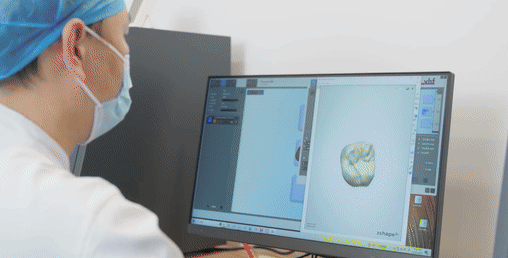Home / News / Industry Information / How Can Digital Technology Make Dental Treatment More Comfortable And Convenient?
Digital technology is leading the development of dental medicine.
Since the world's first denture CAD/CAM system was clinically implemented in 1987, with the continuous advancement of technology, digital technology has penetrated every aspect of modern dental care, profoundly changing the way people see the dentist.

Are you curious about how many steps it takes from settling into the dental chair to wearing your finished teeth?
Step 1: Digital Scanning Technology (Digital Impression)
This is a precise and lightweight digital intraoral scanner. After the doctor prepares the "abutment teeth" (preliminary cleaning and trimming of teeth with caries), it quickly, accurately, and completely creates a 3D model of your mouth in just a few minutes.
▲Digital Intraoral Scanning
This is often our first experience with digital technology. Compared to traditional impression-taking methods, this method greatly improves efficiency and enhances patient comfort.
Next, the doctor will continue treatment in the dental chair. At this point, the patient's intraoral data has been transmitted to the Dental Digitalization Center, a unique technical support platform for dental hospitals.
▲ Digital Dental Center
Here, a professional team of dental technicians will work closely with doctors to complete the entire process from design to manufacturing, helping them achieve their ideal treatment plan!
Step 2: Computer-Aided Design and Manufacturing (CAD/CAM)
The Digital Dental Center boasts a wide array of cutting-edge, high-tech equipment. Among them, the most commonly used in clinical practice is the chairside CAD/CAM system.
For example, digital dental technology is widely used in minimally invasive dental restorations such as inlays and veneers. Commonly used dental restoration materials are porcelain and composite resins, which offer an excellent balance of biocompatibility and aesthetics to meet the diverse needs of patients.
▲ Restoration Design and Precision Machining
First, a team of professional technicians creates a 3D color model based on the patient's intraoral data. They then create a personalized aesthetic design based on the doctor's treatment plan and patient needs.
Using computer-aided design (CAD) technology, parameters such as margins, interproximal connections, and occlusion between the inlay and abutment can be precisely controlled to create the ideal embryo. After the design is finalized, a high-precision computer-controlled machining (CAM) system rapidly and precisely cuts the original dental restoration.
▲ Inlays being tried on and adjusted on the model
During this process, the design and plan for the dental restoration are presented completely visually. This visualization not only facilitates efficient communication between the doctor and technician, but also helps patients understand the treatment process and expected results, strengthening their confidence.
Step 3: Finished Product—The Final Restoration
Once the original dental restoration is processed, it undergoes a series of steps, including fine-tuning, color matching, glazing, staining, and sintering. The final restoration is then infused with soul through the skilled hands of the technicians.
▲ Technician's Handicraft
Compared to traditional methods, chairside digital dental technology can produce an ideal dental restoration in as little as a few hours. This not only significantly saves patients time but also enhances their sense of engagement and trust.
For patients with complex dental problems requiring general anesthesia, this unique technique is a key solution, allowing them to complete all their dental treatments the moment they wake up!
▲ Medical and technical collaboration ensures smooth dental treatment under general anesthesia
This is just the tip of the iceberg when it comes to digital technology applications.
These advanced technologies are already well-established in clinical practice. In the future, with the continuous advancement of technology, we will provide more comfortable, optimal, and professional dental services, bringing benefits to our patients.
Is there anything else you'd like to know about digital dental technology? Leave a message!